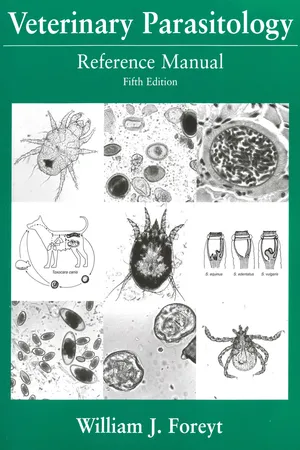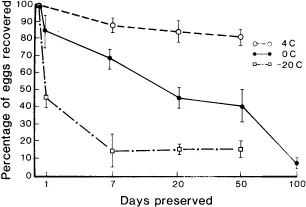
- English
- ePUB (mobile friendly)
- Available on iOS & Android
Veterinary Parasitology Reference Manual
About this book
Veterinary Parasitology Reference Manual, Fifth Edition is a practical, thorough, bench top reference for basic diagnostic veterinary parasitology. The manual provides pertinent information on parasite life cyles, importance, location in the host, zoonotic potential, current literature, diagnosis, and treatment. It also includes step-by-step instructions for the most common diagnostic procedures used in routine veterinary practice.
Sections are organized by animal host species, including dogs; cats; cattle, sheep and goats; llamas; horses; pigs; birds; ratites (ostriches, emus, and cassowaries); and laboratory animals, as well as wildlife, reptiles, marine mammals, and humans. There is a section in which common artifacts found in fecal samples are presented, and the last section includes conversion tables and a list of abbreviations.
Features of the Fifth edition include:
* updated and enhanced references
* information on new drugs
* improved section on parasites of marine mammals
* sections on parasites of laboratory animals and humans
* over 500 photographs and figures
Readers will find this to be an easily accessible and accurate resource for information about parasites in a variety of animals - wild, domestic, common and exotic.
Frequently asked questions
- Essential is ideal for learners and professionals who enjoy exploring a wide range of subjects. Access the Essential Library with 800,000+ trusted titles and best-sellers across business, personal growth, and the humanities. Includes unlimited reading time and Standard Read Aloud voice.
- Complete: Perfect for advanced learners and researchers needing full, unrestricted access. Unlock 1.4M+ books across hundreds of subjects, including academic and specialized titles. The Complete Plan also includes advanced features like Premium Read Aloud and Research Assistant.
Please note we cannot support devices running on iOS 13 and Android 7 or earlier. Learn more about using the app.
Information
Section 1
DIAGNOSTIC PARASITOLOGY
Collection and Submission of Samples
Fecal Samples


Fecal Flotation
Blood
Table of contents
- COVER
- CONTENTS
- TITLE PAGE
- COPYRIGHT
- PREFACE
- INTRODUCTION
- Section 1: DIAGNOSTIC PARASITOLOGY
- Section 2: GENERAL PARASITOLOGY
- Section 3: PARASITES OF DOGS
- Section 4: PARASITES OF CATS
- Section 5: PARASITES OF CATTLE, SHEEP, AND GOATS
- Section 6: PARASITES OF LLAMAS
- Section 7: PARASITES OF HORSES
- Section 8: PARASITES OF PIGS
- Section 9: PARASITES OF BIRDS
- Section 10: PARASITES OF RATITES (OSTRICHES, EMUS, AND CASSOWARIES)
- Section 11: PARASITES OF LABORATORY ANIMALS
- Section 12: PARASITES OF WILDLIFE
- Section 13: PARASITES OF MARINE MAMMALS
- Section 14: PARASITES OF REPTILES
- Section 15: PARASITES OF HUMANS
- Section 16: COMMON ARTIFACTS IN FECES
- Section 17: TABLES
- INDEX